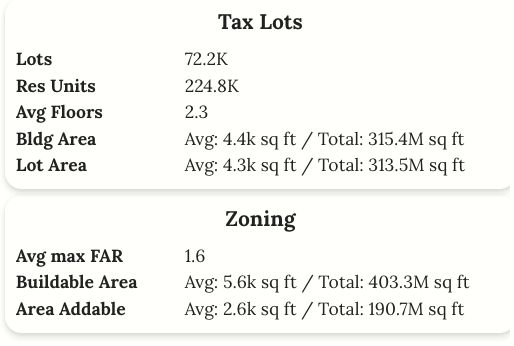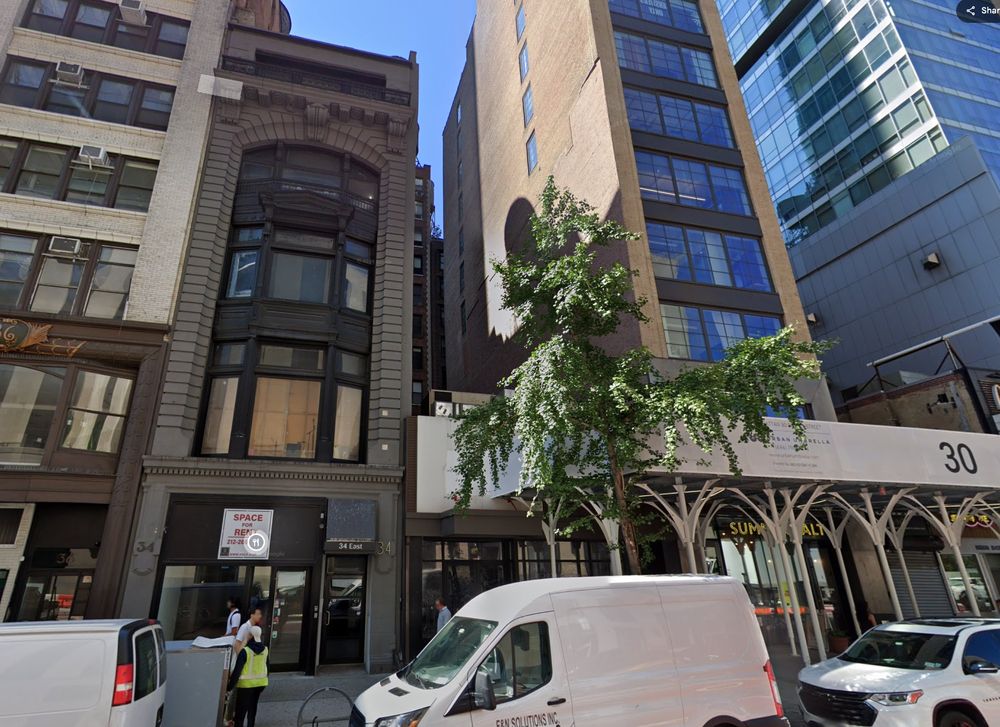1. Front: To put your garbage bins
2. Height: To make the streetscape pretty
3. Side: To give you space to breathe



1. Front: To put your garbage bins
2. Height: To make the streetscape pretty
3. Side: To give you space to breathe
Showing block-level averages.
First: Number of floors is mostly below 4, often below 1.
Second: The zoned floor-area-ratio is mostly below 4, often below 1.
(you might notice that these maps are similar)


Showing block-level averages.
First: Number of floors is mostly below 4, often below 1.
Second: The zoned floor-area-ratio is mostly below 4, often below 1.
(you might notice that these maps are similar)
Within 0.5 miles of the IBX, we have 225,000 units, with average Floor-Area-Ratio of 1.6
If we doubled FAR and assumed that about 50% of the total FAR gets used over 10 years, we'd add:
200,000 units of housing!
🧵


Within 0.5 miles of the IBX, we have 225,000 units, with average Floor-Area-Ratio of 1.6
If we doubled FAR and assumed that about 50% of the total FAR gets used over 10 years, we'd add:
200,000 units of housing!
🧵
An example: IBX in NYC is estimated to have daily ridership of 115,000.
What assumptions go into this? I went through a 1,077 page report and still don't know.

An example: IBX in NYC is estimated to have daily ridership of 115,000.
What assumptions go into this? I went through a 1,077 page report and still don't know.
But I couldn't find a way to analyze the route on a map.
So I created a dataset of the route and stops. Feedback welcome!
Unofficial and using some hand coding, so give me feedback!
github.com/cgoldammer/i...

But I couldn't find a way to analyze the route on a map.
So I created a dataset of the route and stops. Feedback welcome!
Unofficial and using some hand coding, so give me feedback!
github.com/cgoldammer/i...
This exists, but:
1. Alterations + dominate -
2. Alterations (+ and - together) are dominated by new construction (>20K/year).
Own chart, Housing DB

This exists, but:
1. Alterations + dominate -
2. Alterations (+ and - together) are dominated by new construction (>20K/year).
Own chart, Housing DB
- ULURP actions since 1996
- % of units by neighborhood
- Warning: Many of these rezonings might be minor.
- This doesn't include changes through the zoning code (e.g. the contextual downzoning)

- ULURP actions since 1996
- % of units by neighborhood
- Warning: Many of these rezonings might be minor.
- This doesn't include changes through the zoning code (e.g. the contextual downzoning)
Challenge accepted, lots of links to cute houses in thread.
If we restricted to residential units with lot frontage less than 11 ft, we get 88 results (link below).
🧵

Challenge accepted, lots of links to cute houses in thread.
If we restricted to residential units with lot frontage less than 11 ft, we get 88 results (link below).
🧵
Permits, sales, much more coming soon. Notifications coming soon! Beta, so give me feedback if stuff is going wrong. Will improve quickly!
citytracker.ai
Permits, sales, much more coming soon. Notifications coming soon! Beta, so give me feedback if stuff is going wrong. Will improve quickly!
citytracker.ai
Result: "Increases of these magnitudes would not be perceptible".
But ... to get there, we required repeated in-person measurement and complex analysis.
We should be able to predict this result! It's pretty obvious.
So let's look at the environmental assessment for a recent "controversial" rezoning, Arrow Linen. 244 units in Brooklyn.
7 versions over 3 years, latest at 289 pages. Contents in image.
A 🧵

Result: "Increases of these magnitudes would not be perceptible".
But ... to get there, we required repeated in-person measurement and complex analysis.
We should be able to predict this result! It's pretty obvious.
So let's look at the environmental assessment for a recent "controversial" rezoning, Arrow Linen. 244 units in Brooklyn.
7 versions over 3 years, latest at 289 pages. Contents in image.
A 🧵

So let's look at the environmental assessment for a recent "controversial" rezoning, Arrow Linen. 244 units in Brooklyn.
7 versions over 3 years, latest at 289 pages. Contents in image.
A 🧵
Is the 730 days the ULURP process (filing => approval)? I'm getting very different answers.
(Not commenting on the politics of it for now)

Is the 730 days the ULURP process (filing => approval)? I'm getting very different answers.
(Not commenting on the politics of it for now)




Buildings in NYC with 1-2 floors in locations with price per square foot above $1,500.
Feast your eyes on this land use!




Buildings in NYC with 1-2 floors in locations with price per square foot above $1,500.
Feast your eyes on this land use!
Buildings with 1-2 floors in great locations: Predicted price per square foot above $1,000
There is 5,700 of them, excluding parking lots, churches, etc.
Examples in 🧵
Buildings with 1-2 floors in great locations: Predicted price per square foot above $1,000
There is 5,700 of them, excluding parking lots, churches, etc.
Examples in 🧵
Better framing: We found a cheap way of making a block 20% better. So let's do that everywhere, to get the benefits without displacement!
Better framing: We found a cheap way of making a block 20% better. So let's do that everywhere, to get the benefits without displacement!
A developer said: We can turn 2 dwelling units into 10 (or 15, stylized timeline in image).
Other developers likely ... wait and see until new comps are set. *If* that's good, development explodes.

A developer said: We can turn 2 dwelling units into 10 (or 15, stylized timeline in image).
Other developers likely ... wait and see until new comps are set. *If* that's good, development explodes.
www.silive.com/news/2025/10...

www.silive.com/news/2025/10...
If this holds up, it should be possible almost anywhere in the neighborhood, see qualifying lots in image.

If this holds up, it should be possible almost anywhere in the neighborhood, see qualifying lots in image.
It's because of how transit-oriented development (TOD) was handled, requiring a 5,000 sq ft lot. Common in SI, rare elsewhere.
The map shows % of lots that qualify for TOD
Thanks @3underscores.bsky.social for the lead!

It's because of how transit-oriented development (TOD) was handled, requiring a 5,000 sq ft lot. Common in SI, rare elsewhere.
The map shows % of lots that qualify for TOD
Thanks @3underscores.bsky.social for the lead!
If demand increases, we'll see sky-high rents. So it's "causing" high rents, right?
No! It's satisfying formerly unmet demand.
But the restrictions make this correlation *more* misleading.

If demand increases, we'll see sky-high rents. So it's "causing" high rents, right?
No! It's satisfying formerly unmet demand.
But the restrictions make this correlation *more* misleading.
On the left is the district steam system, run by ConEd.
On the right are ConEd's business leads.


On the left is the district steam system, run by ConEd.
On the right are ConEd's business leads.
Step 1: Do the inverse of a land value tax: lower taxes for lower density.
=> Not enough housing and vacant plots
=> Step 2: We need tax incentive program to build more, but it’s not so well designed
=> We get *some* large buildings, at exactly 99 units, nothing bigger
Step 1: Do the inverse of a land value tax: lower taxes for lower density.
=> Not enough housing and vacant plots
=> Step 2: We need tax incentive program to build more, but it’s not so well designed
=> We get *some* large buildings, at exactly 99 units, nothing bigger
The baseline effective tax rate for residential buildings (assessment rate x tax rate)
Class 1 (1-3 units) = 1.2%
Class 2 (> 3 units) = 5.6%
Example in image per CSS report:

The baseline effective tax rate for residential buildings (assessment rate x tax rate)
Class 1 (1-3 units) = 1.2%
Class 2 (> 3 units) = 5.6%
Example in image per CSS report:

